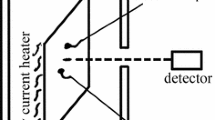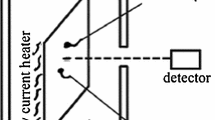Abstract
High-chromium containing single-phase ferritic alloy surfaces are commonly used in high-temperature radiant heating applications. The surface emissivity number at any given temperature determines the rate of conversion from internal to radiant energy. In this article, using experimental data and numerical simulations, we have determined the emissivity of a Fe-5.8 pct Al-22 pct Cr alloy surface, as a function of temperature. Experimentally measured temperature values were compared with results from numerical simulations in order to accurately determine the surface emissivity. In the temperature range of 1200 to 1350 K, the emissivity was noted to increase with temperature.





Similar content being viewed by others
Notes
The molybdenum disilicide material chosen is manufactured by MHI Inc. and sold under the tradename of MP1800. The pin-holes were specially introduced by the manufacturer for this test.
INCONEL is a trademark of INCO Alloys International, Huntington, WV.
Abbreviations
- F :
-
radiation shape factor between the surface and another surface i
- g :
-
gravitational acceleration
- I :
-
unit tensor
- k :
-
thermal conductivity (W/m K)
- p :
-
pressure (N/m2)
- q ‴ :
-
volumetric heat dissipation rate (W/m3)
- R :
-
gas constant for air
- t :
-
transpose
- T :
-
temperature (K)
- V :
-
velocity (m/s)
- α :
-
thermal diffusivity (m2/s)
- ε :
-
surface emissivity
- μ :
-
viscosity (kg/m s)
- ρ :
-
density (kg/m3)
- σ :
-
Stephan–Boltzmann constant
- air :
-
air
- solid :
-
all solid parts
References
W. Betteridge: Br. J. Appl. Phys., 1955, vol. 6, pp. 301–06
K. Savolainen, J. Mononen, R. Ilola, and H. Hänninen: Material Selection for High Temperature Applications, http://eny.hut.fi/research/process_integration/bioifgt_Jan2004Dec2005/Savolainen_etal_2005.pdf, October 2005
G.H. Geiger, D.R. Poirier: Transport Phenomena in Metallurgy, Addison-Wesley, New York, NY, 1973, pp. 361–70
R. Siegel, J.R. Howell: Thermal Radiation Heat Transfer, 2nd ed., Taylor and Francis, New York, NY, 1981, pp. 122–161
W.M. Kays, M.E. Crawford: Convective Heat and Mass Transfer, 3rd ed., McGraw-Hill, New York, NY, 1993, pp. 361–370
S.V. Patankar: Numerical Heat Transfer and Fluid Flow, Hemisphere Publishing, New York, NY, 1980, pp. 79–134
Kanthal company web site, www.kanthal.com
This material is based upon the work supported by MHI Inc. and NSF. Any opinions, findings, and conclusions or recommendations expressed in this material are those of the author(s) and do not necessarily reflect the views of the funding sources for the research.
Author information
Authors and Affiliations
Corresponding author
Additional information
Manuscript submitted February 4, 2007.
Rights and permissions
About this article
Cite this article
Bhagat, K., Reddy, G., Jog, M. et al. A Technique to Determine the Emissivity with the Temperature of a Fe-5.8 Pct Al-22 Pct Cr Alloy. Metall Mater Trans B 38, 725–728 (2007). https://doi.org/10.1007/s11663-007-9072-z
Published:
Issue Date:
DOI: https://doi.org/10.1007/s11663-007-9072-z




